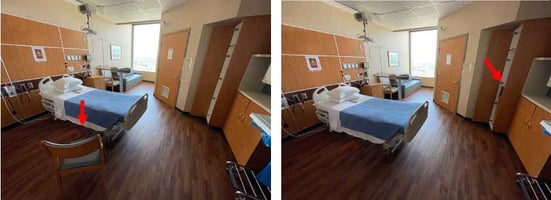 As many readers know, I’ve recently co-written a book about applying the principles of human-centered design to healthcare writ large. Hence, it cannot be surprising that my interest was piqued when an article appeared last month in the British Medical Journal titled “Effect of chair placement on physicians’ behavior and patients’ satisfaction: randomized deception trial.” Could it be that the simple placement of a chair affected both how physicians dealt with hospitalized patients and how satisfied patients were with the care of their doctors? Yes, yes it could.
As many readers know, I’ve recently co-written a book about applying the principles of human-centered design to healthcare writ large. Hence, it cannot be surprising that my interest was piqued when an article appeared last month in the British Medical Journal titled “Effect of chair placement on physicians’ behavior and patients’ satisfaction: randomized deception trial.” Could it be that the simple placement of a chair affected both how physicians dealt with hospitalized patients and how satisfied patients were with the care of their doctors? Yes, yes it could.
The researchers (all physicians or medical students at the University of Texas Southwestern Medical School) hypothesized that they might use the behavioral change concepts of nudges and choice architecture to modify how physicians acted and how patients perceived the care that they received. As a reminder, choice architecture is the “design of different ways in which [options] can be presented to decision makers and the impact of that presentation on decision making.” In Thaler and Sunstein’s seminal book Nudge, the authors define their topic as “any aspect of the choice architecture that alters people’s behavior in a predictable way without forbidding any options or significantly changing their economic incentives” (p. 8).
The study was performed at Parkland Memorial Hospital in Dallas. It was a double blind, randomized controlled deception trial. As the authors note, “[d]eception studies purposefully withhold some information from participants to assess outcomes that may otherwise be influenced by knowledge of the study’s objective.” In this case, the hospital physicians who were being studied were informed (here’s the deception part) that the aim of the study was simply to observe differences in practice and to provide medical students with clinical experience in the inpatient setting. If the hospitalists had known the actual purpose of the study, it’s likely they would have consciously or subconsciously changed their behavior (see the Hawthorne effect). The patients were merely told that the purpose of the study was to investigate practice patterns, with no mention of the chair.
The control group consisted of typical hospital rooms with a chair folded near the closet. For those who were randomized to the intervention group, a medical student took out the chair and placed it within three feet of the bed, facing the bed.

The students then met with the physician outside the room and observed the patient encounter silently from the corner of the room. They recorded the physician’s sitting behavior, time in the room, and general etiquette, such as knocking before entering the room and making introductions. Afterward, the students administered questionnaires to both the patients and the physicians.
What did they find? Physicians who walked into a patient room with a chair positioned facing the patient were much more likely to sit down when interacting with patients during their daily rounds (63%) versus physicians who had to remove the chair from the closet and position it themselves (8%). Further, physicians in the intervention group (i.e., a chair was placed facing the patient before the doctor entered the room) received higher patient satisfaction and communication scores on validated instruments. Wow!
The simple act of sitting when addressing patients has benefits of which most of us are unaware. In this study, the researchers showed that simply sitting with a patient was associated with a 5% increase in satisfaction of patients. The authors note other studies that show that patients perceived physicians who sat to be more compassionate, more caring, and more encouraging of questions. Perhaps we interpret our caregivers’ motives more altruistically if they speak to us from the same level. Maybe the action of just sitting down makes it seem like the doctor is signaling that they will spend the appropriate time with us to explain what’s going on and how we’re doing.
The hospital can be a scary place. Anything that can lessen the anxiety that patients may naturally feel is a good thing. But when the intervention doesn’t cost anything in terms of money, time, or resources, it’s a no-brainer. As the authors note (and my LinkedIn stream supports), nudges such as the placement of a chair to improve patient communication and satisfaction are welcomed by all involved parties. Choice architecture isn’t just an essential concept for healthcare IT and electronic health record (EHR) specialists to consider; its use extends to everyone in healthcare from the C-suite on down.